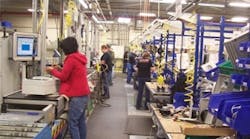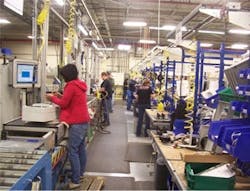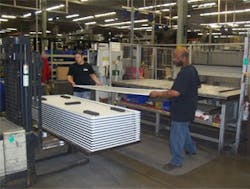It takes a good home to know how to build a good home – even when constructing protective housing for electronics and electrical components.
So, though it's headquartered in Germany as part of the Friedhelm Loh Group, Rittal Corp. (www.rittal.us) has been operating in the United States for 33 years, manufacturing in Ohio for 26 years, and designing, building, selling, and supporting its enclosures and other products for North America at its plant in Urbana, OH, for about 20 years. The 512,000-square-foot plant is located on 105 acres, and its approximately 600 employees cut, form, weld, paint, and assemble about 1,200 enclosures and wall-mount enclosures per day and more than 50 integrated enclosures with cooling systems per day (Figure 1).
Rittal's main enclosure lines include freestanding IT server and network racks, industrial enclosures such as its TS8, and wall-mount and junction boxes. In 2003, the Ohio plant added production of air conditioners, and later added fans, and liquid-cooled packages (LCPs) for server racks and plant floors. Many of these devices are now Internet Protocol (IP) enabled via Ethernet networking.
One of Rittal's primary manufacturing strategies is to build highly customized enclosures, but to do it using standardized components. This meets the individual requirements of its users, but enables the company to construct enclosures much more efficiently and quickly than traditional customization from scratch.
These "customized off-the-shelf" projects begin in the Urbana plant's engineering design group and system consultancy department, where Rittal's engineers work with machine builders, system integrators and other clients to design the most appropriate enclosure for their particular equipment and facilities. Subsequent support services include a prioritized phone system, and an upcoming Andon visual communication system that will get Rittal up to a greater than 99% human answer rate.
Despite the flexibility granted by its custom off-the-shelf method, Rittal has developed and added many new products in recent years, and this forces it to continually reexamine and reconfigure its own production lines at the Urbana facility. "We do Kaizen analyses of all our lines across all the functions and departments that contribute to them, and determine the best layouts for our goals," says Tony Varga, president, Canada, and senior vice president, North American Sales, of Rittal. "We're in the second iteration of our cooling line; we redesigned our material feed to that line this year, and we'll also begin revising our stainless steel wallmount enclosure line this year."
In its large fabrication area, workers operate about a dozen machining centers, such as Trumpf laser cutters, TruePunch punch machines, robotic welders, and tooling machines, which access CAD designs from the engineering department; and begin to cut, fold, and weld Rittal's locally sourced carbon steel and aluzinc into its basic frames and cabinets. If unique customizations are needed for one or several products, they're often done on a Keisling Perforex BC 1007 automated, panel-fabrication machine in the plant's modification area (Figure 2).
Varga adds that Rittal practices a five-S plant floor discipline and adds a sixth S to prioritize safety. These policies include standardization; sorting out what's needed for each job; setting work areas in order; "shine" to keep work areas clean and reduce clutter ; “sustain” to further eliminate effort in work areas; and building awareness of safety into all activities.
After fabrication – but before final gasketing/insulation, assembly, inspection, warehousing and packing – all of Rittal's frames, doors and other components are thoroughly cleaned, chemically treated in eight steps, painted or powder coated, dried or cured, and even nano-coated according to requested specifications (Figure 3). All of this happens on its flexible, three-mile-long painting line, which Steve Sullivan, Rittal’s training supervisor, reports is the longest line in North America for parts this size outside of the automotive industry. These and Rittal's other lines are using increasingly PC-based documentation for even more accurate product tracking and tracing. This is important because the plant operates an 8.5-story warehouse with 7,000 skid locations, which are served by a Viastore automatic storage and retrieval system (ASRS).
"Rittal usually reinvests a lot when the overall economy slows because there's less production pressure and more downtime to improve our lines," explains Varga. "The painting line was established after 2001, and during the 2008-09 recession, the company invested about $10 million in the fabrication area on new laser equipment and a new 'Factory Focus' area to enable smaller-quantity, customized orders. In 2012, we invested another $12 million, which included about $8 million for our automated wall-mount line, as well as adding new robot welders and special paint feeding equipment. Over Christmas 2013, we replaced our old punch-and-fold center with a new Salvagnini S4xe line."
Besides reinvesting to keep its production lines efficient and nimble, Rittal also devotes considerable resources to staff development. According to Sullivan,all employees from the top-down participate in the "Learning Island" that simulates the factory's work cells and other production areas—and the skills required in each. Each weekly, eight-hour class has about a dozen students, who assume one of 12 different roles, including assembly, tooling, safety, quality assurance, inventory, sales, customer service and other skills. They also learn the Rittal Production System philosophy that consists of three levels of identifying waste and reorganizing to reduce inefficiency.
"We train our staff to think about production issues and how to improve them instead of just doing a job," adds Sullivan. "We try to train everyone to want to be part of new solutions and to be empowered to do it. Having employees that are as capable and flexible as our plant is especially important now because we’re constantly innovating to be on the leading-edge of the customer’s requirements.”



